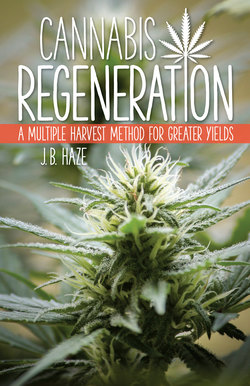Читать книгу Cannabis Regeneration - J.B. Haze - Страница 20
На сайте Литреса книга снята с продажи.
ОглавлениеCHAPTER TWO
THE MRS
The Marijuana Regeneration System is offered not as a substitute for seed and clone growing, but as an additional technique—an extra arrow in your quiver. It’s a nice pointy one too, presenting a sharp alternative to what’s considered the norm.
The benefits of regeneration are especially bountiful for the hobby grower; the small-time guy (like me, and possibly you) growing one or two plants at a time for personal consumption. Medicinal growers, with strict plant limits, will also find The MRS a great way to maintain consistent supply and quality lineage. This is not to say that The MRS can’t be expanded out to a multi-plant, multi-light monster grow. It undoubtedly can, and we’ll discuss expanding the system later. But for now, let’s keep it tight and focused on the small time cultivator.
Generally speaking, a grower like you or I does not want to deal with expensive lights, air filters, duct work, cloning stations (with their own specific lighting requirements), dozens of pots and bags of soil. Growing for the love of it (and to keep our heads in the right place), we like it easy, simple and cost-effective. This way we can love our ladies with total devotion—caressing the very best from them. And, under the umbrella of this intimate relationship, between grower and plant, The MRS really shines, delivering yield and quality from a tiny space.
The process of regeneration unfolds along a timeline like this:
1. The rescue, stabilization and initial regeneration of the donor plant (the just harvested plant—nothing more than a stump at this point), which will take from four to 14 days. During this period new growth will magically spring forth.
2. A four to five week period of vigorous vegetation and training; the key to The MRS success. Note that this period is no longer than any normal vegetative one.
3. A regular eight to 10 week period for complete (and lush) flowering and budding.
As an overall growing discipline, regeneration offers multiple benefits, including:
High yield (60 to 100 colas per 12-inch (three and a half gallon) pot. (See Chapter 3)
The potential to increase yield and quality with each subsequent harvest. (See Chapter 4)
Minimal power usage (just a single, dedicated, low wattage light). (See Chapter 4)
Space and consumables efficiency (one pot, minimum grow medium and nutrients). (See Chapter 4)
That’s all well and good—and it certainly sounds wonderful. But how do you do it? How do you infuse life into the scraggly, stump-like remains of your just harvested plant? The defined procedure for physically putting The MRS system to work will also be taught:
Tools and supplies needed to undertake regeneration. (See Chapter 5)
Rescue and stabilization of the plant. Post-harvest vascular management. (See Chapter 6)
Initial regrowth. (See Chapter 7)
Staking, teasing and training prior to re-flowering. (See Chapter 8)
Defoliation and maintenance prior to re-harvest. (See Chapter 9)
Doing it all over again, the next harvest. (See Chapter 10)
The above chapters cover the application of The MRS in a step-by-step manner, from cut to completion, with photographs detailing the plant’s growth patterns. Taken together, all you need to fully implement The MRS (thus repeatedly regrowing the same plant) is covered.
The final chapters are a little different, stepping outside the clearly defined goals and aims of the original system. Here we learn how to adjust our procedures: Allowing continuous harvests and expanding The MRS into a multi-plant, multi-light behemoth capable of popping out buds by the thousands. We also explore combining regeneration with the established practices of cloning and controlled pollination (seed manufacture):
The third harvest and beyond. (See Chapter 11)
Cloning and pollinating with The MRS. (See Chapter 12)
Expanding to grow multiple plants. (See Chapter 13)
Considering all that regeneration (The Mrs in particular) has to offer in the way of enhanced yield, cost-effective production and potent end product, I find it surprising that the approach has not become more widely known or exploited. My theory as to why this should be involves the evolution of the plant and this simple observation: Cannabis, since it first evolved (eons ago, in the carbon rich atmosphere it still desires), has always grown outdoors. Regeneration does not occur, in the cannabis plant, outdoors—it’s simply not possible. Here’s why: Outdoors, you are harvesting during the very short days—those with 12 hours of light or less. Regeneration, if it is to trigger, requires at least 18 hours of light per day (and preferably continuous light for consistent results). This sudden lengthening of the day does not occur naturally. You cannot reach up into the sky and halt dear old Sol’s movements, elongating the daylight hours. In fact, the photoperiod can only be manipulated to achieve an instantly stretched day indoors. And, it’s only very, very recently in the cannabis plant’s evolution that she’s encountered indoor lighting.
Could this fact, that regeneration is not encountered outside, be the reason the concept has remained sub rosa? Whatever the answer, I am convinced that now is the time for regeneration to come out of the proverbial closet; to shine, and to take its place in grow rooms across the world. The MRS is a friendly and easy way to achieve this dream.
